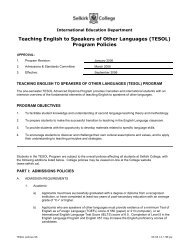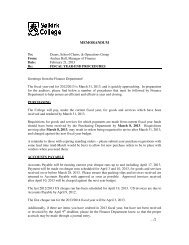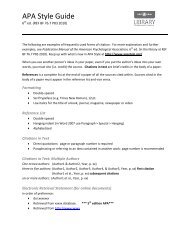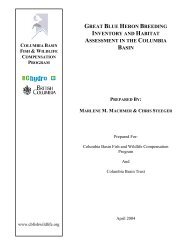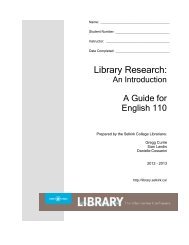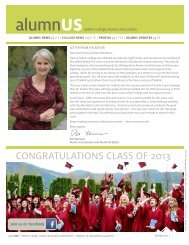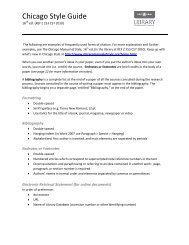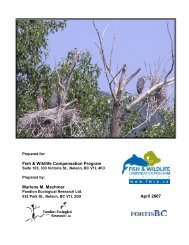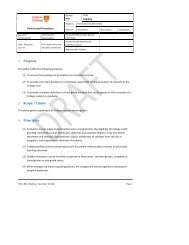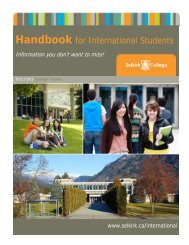selk irk.ca - Selkirk College
selk irk.ca - Selkirk College
selk irk.ca - Selkirk College
Create successful ePaper yourself
Turn your PDF publications into a flip-book with our unique Google optimized e-Paper software.
digital arts and new media<br />
• The Digital Arts & New Media program<br />
requires an extraordinary commitment of<br />
time and energy. Explain why you feel you<br />
are prepared to make this commitment at this<br />
time in your life.<br />
• Success in this program involves receiving<br />
constructive criticism and feedback from<br />
peers and instructors. Explain how you have<br />
dealt with constructive criticism in the past.<br />
Provide examples.<br />
Portfolio<br />
Admission to this full time program is competitive.<br />
The portfolio is a very important part of<br />
the appli<strong>ca</strong>tion process and appli<strong>ca</strong>nts should<br />
take <strong>ca</strong>re to ensure that their work is presented as<br />
strongly as possible. Digital Arts & New Media is<br />
looking for a demonstration of visual awareness,<br />
creativity and techni<strong>ca</strong>l skill. Appli<strong>ca</strong>nts should<br />
choose pieces for their portfolios that demonstrate<br />
the nature, scope and direction of their work. The<br />
portfolio pieces may be of any medium and they<br />
need not be specific to new media. Appli<strong>ca</strong>nts<br />
should give special attention to the following<br />
guidelines when preparing their portfolios.<br />
• The number of pieces in an appli<strong>ca</strong>nt’s<br />
portfolio will vary depending on the manner<br />
in which the appli<strong>ca</strong>nt works. Generally,<br />
the admissions committee would like to see<br />
a minimum of eight (8) and a maximum of<br />
twenty-four (24) pieces.<br />
• Portfolios should be brought to the interview<br />
and only mailed if, be<strong>ca</strong>use of distance, the<br />
appli<strong>ca</strong>nt is unable to attend their interview<br />
in person.<br />
• Two-dimensional works may be presented in<br />
their original form. Three-dimensional pieces<br />
or any works on a large s<strong>ca</strong>le should not be<br />
brought to the interview but represented by<br />
photographs.<br />
• An appli<strong>ca</strong>nt’s portfolio must be the<br />
appli<strong>ca</strong>nt’s own original work.<br />
• Appli<strong>ca</strong>nts should organize their work and<br />
set it out so that it shows development over a<br />
period of time or group it according to type.<br />
• Appli<strong>ca</strong>nts should bring their workbooks and<br />
journals. School assignments and independent<br />
explorations will also be helpful to the<br />
Admissions Committee.<br />
• Appli<strong>ca</strong>nts must keep their presentations<br />
simple and neat. Work should not be matted<br />
or framed.<br />
• If an appli<strong>ca</strong>nt includes photographs of work,<br />
each must include a list of the materials used,<br />
size of the piece, title and date.<br />
• Examples may include:<br />
• Photography: printed photographs or digital<br />
images.<br />
• New Media: Computer generated still<br />
images, moving images (video or animation).<br />
• Traditional art: paintings, drawings,<br />
sculptures or other traditional media<br />
• Theatre/Drama: Collection of images<br />
(reviews, photos, programs), video or audio<br />
tapes<br />
• Music: audio or videotape of your<br />
performance(s) or composition(s).<br />
Please submit your portfolio in one of the following<br />
formats:<br />
• CD<br />
• DVD<br />
• Website address<br />
• Hard copy<br />
Note: If submitting digital image files on a CD or<br />
DVD, they should be in jpeg format. Video and<br />
other time-based work may be submitted on DVD.<br />
If you are unable to attend an interview you<br />
may send your portfolio to us. Please note the<br />
following:<br />
Labels: Be sure to label each item with your<br />
name, contact information, the date the piece<br />
was made, and medium. With your portfolio<br />
include a printed copy of all the contents as well<br />
as your name and contact information. You are<br />
responsible for all costs for the submission and<br />
return of your portfolio.<br />
Note: Appli<strong>ca</strong>nts may use a video <strong>ca</strong>mera to document<br />
artwork -- paintings, drawings, sculpture. It is<br />
strongly recommended that you do not send original<br />
video or audiotape of performance.<br />
Interview<br />
All appli<strong>ca</strong>nts are required to participate in an<br />
interview with instructors from the Digital Arts<br />
& New Media Program. Appli<strong>ca</strong>nts are to present<br />
their portfolio at the interview. In situations where<br />
a face-to-face interview is not possible, a telephone<br />
interview will be arranged. The interview is an<br />
opportunity for appli<strong>ca</strong>nts to introduce themselves,<br />
present their work and discuss their interests<br />
within digital media. The instructors will assess<br />
the appli<strong>ca</strong>nt’s preparedness for entry into the<br />
program and will ask about commitment, goals and<br />
expectations, computer and software skills, design<br />
knowledge, experience and communi<strong>ca</strong>tion skills.<br />
It is also an opportunity for appli<strong>ca</strong>nts to ask any<br />
questions they might have about the program and<br />
for faculty to recommend upgrading if necessary.<br />
COMPUTER AND<br />
SOFTWARE KNOWLEDGE<br />
Demonstrated competency in computer hardware<br />
and software technology, keyboarding, including<br />
Internet skills and word processing skills is required<br />
prior to entering the program. Basic computer,<br />
keyboarding and Internet skills are not taught as<br />
part of the Digital Arts & New Media curriculum.<br />
Appli<strong>ca</strong>nts who do not possess these skills must<br />
consult with the School Chair before making a<br />
formal appli<strong>ca</strong>tion to the program. Upgrading<br />
may be required. The Digital Arts & New Media<br />
program delivers curriculum on both the Apple<br />
Mac OS X and Microsoft Windows platforms.<br />
Approximate Expenses<br />
Visit <strong>selk</strong><strong>irk</strong>.<strong>ca</strong>/tuition/fees/ for approximate<br />
fee information. Please check with the program<br />
contacts for Digital Arts & New Media for any<br />
additional information.<br />
PROJECT COSTS AND SUPPLIES<br />
Students should plan and budget for the purchase<br />
of textbooks, art supplies, software, and project<br />
supplies. While not required, the following<br />
items are currently being recommended as items<br />
students may purchase:<br />
• A personal computer (quad core, 4GB of<br />
RAM or greater) with a Firewire (IEEE 1393)<br />
port, DVD burner and a High Speed Internet<br />
connection.<br />
• A Firewire or USB external hard drive<br />
(500GB or greater <strong>ca</strong>pacity)<br />
• A MiniDV or D8 video <strong>ca</strong>mera<br />
• Digital Still Camera 7.0 Mega Pixels or<br />
greater<br />
Faculty <strong>ca</strong>n make recommendations for those<br />
planning on purchasing a computer.<br />
Please check with the program contacts for<br />
Digital Arts and New Media for any additional<br />
information.<br />
Program Courses<br />
DA 100 New Media Systems<br />
This three-day orientation provides students with<br />
the tools and expertise required to participate<br />
in the very techni<strong>ca</strong>l Digital Arts & New Media<br />
Program. Intended to give students a head start<br />
on their learning experience, this course will<br />
introduce students to a range of topics that will<br />
allow them to function in this two-year program<br />
at a high level. Topics covered include: Using<br />
Moodle, POP and IMAP email systems, computer<br />
file management, computer hardware usage, the<br />
Microsoft Windows operating system, universal<br />
networking protocols, printing and data archival<br />
methods and practice.<br />
DA 101 Introduction to Digital Media<br />
The study and profession of digital arts requires a<br />
far-reaching and comprehensive understanding of<br />
how design interfaces with technology. This course<br />
explores the language, practices and systems used<br />
in new media production. Web, print, motion<br />
62 Selk<strong>irk</strong> <strong>College</strong> 12/13 School of Digital Media and Music




